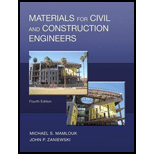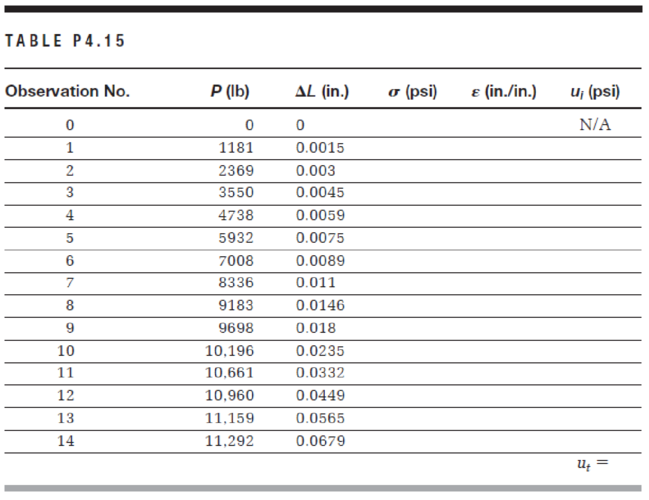
Materials for Civil and Construction Engineers (4th Edition)
4th Edition
ISBN: 9780134320533
Author: Michael S. Mamlouk, John P. Zaniewski
Publisher: PEARSON
expand_more
expand_more
format_list_bulleted
Concept explainers
Textbook Question
Chapter 4, Problem 4.16QP
In Problem 4.15, plot the stress–strain relationship and determine the following:
- a. the elastic modulus
- b. the proportional limit
- c. the yield strength at a strain offset of 0.002
- d. the tensile strength
- e. the magnitude of the load required to produce an increase in length of 0.016 in.
- f. the final deformation, if the specimen is unloaded after being strained by the amount specified in (e)
- g. in designing a typical structure made of this material, would you expect the stress applied in (e) to be reasonable? Why?

Expert Solution & Answer
Want to see the full answer?
Check out a sample textbook solution
Students have asked these similar questions
2. A steel bar, whose cross section is 0.55 inch by 4.05 inches, was tested in
tension. An axial load of P = 30,500 lb. produced a deformation of 0.105 inch over
a gauge length of 2.05 inches and a decrease of 0.0075 inch in the 0.55-inch
thickness of the bar.
Determine the lateral strain. *
Your answer
Determine the axial strain.
Your answer
Determine the Poisson's ratio v.
*
Your answer
Determine the decrease in the 4.05-in. cross-sectional dimension (in inches). *
Your answer
A steel bar, whose cross section is 0.60 inch by 4.10 inches, was tested in tension. An axial load of P = 31,025 lb. produced a deformation of 0.115 inch over a gauge length of 2.10 inches and a decrease of 0.0080 inch in the 0.60-inch thickness of the bar.
a. Determine the lateral strain.
b. Determine the axial strain.
c. Determine the Poisson’s ratio v.
d. Determine the decrease in the 4.05-in. cross-sectional dimension (in inches).
Testing a round steel alloy bar with a diameter of 15 mm and a gauge length of 250 mm produced the stress–strain relationship shown in Figure Determinea. the elastic modulusb. the proportional limitc. the yield strength at a strain offset of 0.002d. the tensile strengthe. the magnitude of the load required to produce an increase in length of 0.38 mmf. the final deformation, if the specimen is unloaded after being strained by the amount specified in (e)g. In designing a typical structure made of this material, would you expect the stress applied in (e) reasonable? Why?
Chapter 4 Solutions
Materials for Civil and Construction Engineers (4th Edition)
Ch. 4 - Name the two primary factors that make aluminum an...Ch. 4 - Prob. 4.2QPCh. 4 - An aluminum alloy specimen with a radius of 0.28...Ch. 4 - An aluminum alloy bar with a radius of 7 mm was...Ch. 4 - Decode the characteristics of a 6063 T831...Ch. 4 - A round aluminum alloy bar with a 0.6 in. diameter...Ch. 4 - An aluminum alloy bar with a rectangular cross...Ch. 4 - A round aluminum alloy bar with a 0.25-in....Ch. 4 - An aluminum alloy rod has a circular cross section...Ch. 4 - An aluminum alloy cylinder with a diameter of 3...
Ch. 4 - A 3003-H14 aluminum alloy rod with 0.5 in....Ch. 4 - The stressstrain relation of an aluminum alloy bar...Ch. 4 - An aluminum specimen originally 300 mm long is...Ch. 4 - A tension stress of 40 ksi was applied on a 12-in....Ch. 4 - A tension test was performed on an aluminum alloy...Ch. 4 - In Problem 4.15, plot the stressstrain...Ch. 4 - Referring to Figure 4.5, determine approximate...Ch. 4 - Prob. 4.18QPCh. 4 - A tensile stress is applied along the long axis of...Ch. 4 - A cylindrical aluminum alloy rod with a 0.5 in....Ch. 4 - Prob. 4.21QPCh. 4 - Discuss galvanic corrosion of aluminum. How can...
Knowledge Booster
Learn more about
Need a deep-dive on the concept behind this application? Look no further. Learn more about this topic, civil-engineering and related others by exploring similar questions and additional content below.Similar questions
- The results of a tensile test are shown in Table 1.5.2. The test was performed on a metal specimen with a circular cross section. The diameter was 3 8 inch and the gage length (The length over which the elongation is measured) was 2 inches. a. Use the data in Table 1.5.2 to produce a table of stress and strain values. b. Plot the stress-strain data and draw a best-fit curve. c. Compute the, modulus of elasticity from the initial slope of the curve. d. Estimate the yield stress.arrow_forwardThe data in Table 1.5.3 were obtained from a tensile test of a metal specimen with a rectangular cross section of 0.2011in.2 in area and a gage length (the length over which the elongation is measured) of 2.000 inches. The specimen was not loaded to failure. a. Generate a table of stress and strain values. b. Plot these values and draw a best-fit line to obtain a stress-strain curve. c. Determine the modulus of elasticity from the slope of the linear portion of the curve. d. Estimate the value of the proportional limit. e. Use the 0.2 offset method to determine the yield stress.arrow_forwardA cylindrical specimen of stainless steel having a diameter of 12.8 mm (0.505 in.) and a gauge length of 50.800 mm (2.000 in.) is pulled in tension. Use the load–elongation characteristics shown in the following table to answer the following: a. Plot the data as engineering stress versus engineering strain. b. Compute the modulus of elasticity. 66 c. Determine the yield strength at a strain offset of 0.002. d. Determine the tensile strength of this alloy. e. What is the approximate ductility, in percent elongation? f. Compute the modulus of resiliencearrow_forward
- A cylindrical specimen of stainless steel having a diameter of 12.8 mm (0.505 in.) and a gauge length of 50.800 mm (2.000 in.) is pulled in tension. Use the load–elongation characteristics shown in the following table: (see attached picture) (a) Plot the data as engineering stress versus engineering strain. (b) Compute the modulus of elasticity. (c) Determine the yield strength at a strain offset of 0.002.(d) Determine the tensile strength of this alloy.e) What is the approximate ductility, in percent elongation? (f) Compute the modulus of resilience.arrow_forwardPROBLEM 1 A steel rod with a cross sectional area of 150 mm? is stretched between two fixed points. The tensile load at 20°C is 5000 N. a.) What will be the stress at -20°C? b.) At what temperature will the stress be zero? Assume a = 11 .7 µm/m°C, and E = 200 Gpa *Show geometry of deformation ©sidewararrow_forwardA tensile test specimen of aluminum alloy having a diameter of 0.5 in. and a gage length of 2 in. was tested to fracture. The complete stress-strain diagram for this specimen is shown below to the left. The small strain portion of this diagram has been enlarged (to the right) to show in more detail the linear portion of the stress-strain diagram. Determine (a) Young's modulus or modulus of elasticity (i.e., the slope of linear portion), (b) yield stress (using the so-called 0.2% offset method from the lecture notes), (c) yield strain (i.e., the strain corresponding to yield stress, not the 0.2%!), (d) ultimate strength (i.e., the peak in stress-strain diagram), (e) rupture stress (i.e., stress at breaking/failure), (f) rupture strain (i.e., the strain corresponding to rupture stress). 80 70 70 60 60 50 50 40 30 30 20 20 10 10 0.005 0.01 0.015 0.02 Strain (in/in) Strain (in/in) Stress (ksi) 0.015 - 0.03 - 0.12 - 0.135 - 0.15 Stress (ksi)arrow_forward
- A high-yield-strength alloy steel bar with a rectangular cross section that has a width of 37.5 mm, a thickness of 6.25 mm, and a gauge length of 203 mm was tested in tension to rupture, according to ASTM E-8 method. The load and deformation data were as shown in Table Using a spreadsheet program, obtain the following:a. A plot of the stress–strain relationship. Label the axes and show units.b. A plot of the linear portion of the stress–strain relationship. Determine modulus of elasticity using the best-fit approach.c. Proportional limit.d. Yield stress.e. Ultimate strength.f. If the specimen is loaded to 155 kN only and then unloaded, what is the permanent deformation?g. In designing a typical structure made of this material, would you expect the stress applied in (f) safe? Why?arrow_forwardA steel alloy specimen having a rectangular cross section of dimensions 19.1 mm x 3.1 mm (0.7520 in. × 0.1220 in.) has the stress-strain behavior shown in the Animated Figure 6.22b. If this specimen is subjected to a tensile force of 98290 N (22100 Ib;) then (a) Determine the amount of elastic strain induced. (b) Determine the amount of plastic strain induced. (c) If its original length is 610 mm, what will be its final length after this force is applied and then released? The elastic modulus for steel is 207 GPa. (a) i (b) i (c) i mmarrow_forward3. The distribution of stress in an aluminum machine component is given (in megapascals) by Ox = y + z? Oy = x + z Oz = 3x + y Txy = 3z2 Tyz = x Txz = %3D Calculate the state of strain at a point positioned at (1,2,4). Use E=70 GPa and v = 0.3arrow_forward
- An aluminum alloy bar with a rectangular cross section that has a width of 12.5 mm, thickness of 6.25 mm, and a gauge length of 50 mm was tested in tension to fracture according to ASTM E-8 method. The load and deformation data were as shown in Table P4.6. Using a spreadsheet program, obtain the following: a. A plot of the stress-strain relationship. Label the axes and show units. b. A plot of the linear portion of the stress-strain relationship. Determine the modulus of elasticity using the best fit approach. c. Proportional limit. d. Yield stress at an offset strain of 0.002 m/m. e. Tangent modulus at a stress of 450 MPa. f. Secant modulus at a stress of 450 MPa. TABLE P4.6 Load (kN) AL (mm) Load (kN) AL (mm) 33.5 1.486 3.3 0.025 35.3 2.189 14.0 0.115 37.8 3.390 25.0 0.220 39.8 4.829 29.0 0.406 40.8 5.961 30.6 0.705 41.6 7.386 31.7 0.981 41.2 8.047 32.7 1.245arrow_forwardDetermine the tensile strain Original length L = 500 mm Tensile deformation = 2.5 mmarrow_forwardA 19-mm reinforcing steel bar and a gauge length of 75 mm was subjected to ten- sion, with the results shown in Table P3.27. Using a computer spreadsheet pro- gram, plot the stress-strain relationship. From the graph, determine the Young's modulus of the steel and the deformation corresponding to a 150-kN load. TABLE P3.27 Load, kN Deformation, mm 54 0.084 163 0.168 284 0.336 330 1.428 366 3.360arrow_forward
arrow_back_ios
SEE MORE QUESTIONS
arrow_forward_ios
Recommended textbooks for you
 Materials Science And Engineering PropertiesCivil EngineeringISBN:9781111988609Author:Charles GilmorePublisher:Cengage Learning
Materials Science And Engineering PropertiesCivil EngineeringISBN:9781111988609Author:Charles GilmorePublisher:Cengage Learning Steel Design (Activate Learning with these NEW ti...Civil EngineeringISBN:9781337094740Author:Segui, William T.Publisher:Cengage Learning
Steel Design (Activate Learning with these NEW ti...Civil EngineeringISBN:9781337094740Author:Segui, William T.Publisher:Cengage Learning

Materials Science And Engineering Properties
Civil Engineering
ISBN:9781111988609
Author:Charles Gilmore
Publisher:Cengage Learning

Steel Design (Activate Learning with these NEW ti...
Civil Engineering
ISBN:9781337094740
Author:Segui, William T.
Publisher:Cengage Learning
Mechanical Properties of Material; Author: Civil Engineering;https://www.youtube.com/watch?v=UZkUvWiNeDs;License: Standard YouTube License, CC-BY